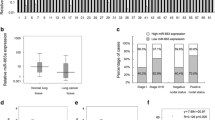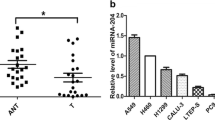Abstract
MicroRNAs (MiRNAs) are small non-coding RNA molecules which act as important regulators of post-transcriptional gene expression by binding 3′-untranslated region (3′-UTR) of target messenger RNA (mRNA). In this study, we analyzed miRNA-34a (miR-34a) as a tumor suppressor in non-small cell lung cancer (NSCLC) H1299 cell line. The expression level of miR-34a in four different NSCLC cell lines, H1299, A549, SPCA-1, and HCC827, was significantly lower than that in the non-tumorigenic bronchial epithelium cell line BEAS-2B. In human NSCLC tissues, miR-34a expression level was also significantly decreased in pT2-4 compared with the pT1 group. Moreover, miR-34a mimic could inhibit the proliferation and triggered apoptosis in H1299 cells. Luciferase assays revealed that miR-34a inhibited TGFβR2 expression by targeting one binding site in the 3′-UTR of TGFβR2 mRNA. Quantitative real-time PCR (qRT-PCR) and Western blot assays verified that miR-34a reduced TGFβR2 expression at both mRNA and protein levels. Furthermore, downregulation of TGFβR2 by siRNA showed the same effects on the proliferation and apoptosis as miR-34a mimic in H1299 cells. Our results demonstrated that miR-34a could inhibit the proliferation and promote the apoptosis of H1299 cells partially through the downregulation of its target gene TGFβR2.






Similar content being viewed by others
Abbreviations
- ATCC:
-
American Type Culture Collection
- CCK-8:
-
Cell Counting Kit-8
- DMEM:
-
Dulbecco’s modified Eagle’s medium
- FBS:
-
Fetal bovine serum
- FITC:
-
Fluorescein isothiocyanate
- Mad:
-
Mothers against decapentaplegic
- miR-34a:
-
miRNA-34a
- MiRNAs:
-
microRNAs
- miRNA-NC:
-
miRNA negative control
- NSCLC:
-
Non-small cell lung cancer
- PCR:
-
Polymerase chain reaction
- qRT-PCR:
-
Quantitative real-time PCR
- SCLC:
-
Small cell lung cancer
- SDS-PAGE:
-
Sodium dodecyl sulfate polyacryl-amide gel electrophoresis
- TGFβR2:
-
Transforming growth factor beta receptor II
- 3′-UTR:
-
3′-untranslated region
References
Jemal A, Bray F, Center MM, Ferlay J, Ward E, Forman D. Global cancer statistics. CA: Cancer J Clin. 2011;61:69–90. doi:10.3322/caac.20107.
Marchevsky AM, Gal AA, Shah S, Koss MN. Morphometry confirms the presence of considerable nuclear size overlap between “small cells” and “large cells” in high-grade pulmonary neuroendocrine neoplasms. Am J Clin Pathol. 2001;116:466–72. doi:10.1309/H40B-8W14-4Q47-03EP.
Fassina A, Cappellesso R, Fassan M. Classification of non-small cell lung carcinoma in transthoracic needle specimens using microrna expression profiling. Chest. 2011;140:1305–11. doi:10.1378/chest. 11-0708.
Winter J, Jung S, Keller S, Gregory RI, Diederichs S. Many roads to maturity: microRNA biogenesis pathways and their regulation. Nat Cell Biol. 2009;11:228–34. doi:10.1038/ncb0309-228.
Peter ME. Let-7 and mir-200 microRNAs: guardians against pluripotency and cancer progression. Cell Cycle. 2009;8:843–52.
Hu J, Xu J, Wu Y, Chen Q, Zheng W, Lu X, et al. Identification of microRNA-93 as a functional dysregulated miRNA in triple-negative breast cancer. Tumour Biol: J Int Soc Oncodevelop Biol Med. 2014. doi:10.1007/s13277-014-2611-8.
Tiwari A, Shivananda S, Gopinath KS, Kumar A. MicroRNA-125a reduces proliferation and invasion of oral squamous cell carcinoma cells by targeting estrogen-related receptor alpha: implications for cancer therapeutics. J Biol Chem. 2014. doi:10.1074/jbc.M114.584136.
Gade S, Porzelius C, Falth M, Brase JC, Wuttig D, Kuner R, et al. Graph based fusion of miRNA and mRNA expression data improves clinical outcome prediction in prostate cancer. BMC Bioinforma. 2011;12:488. doi:10.1186/1471-2105-12-488.
Silber J, James CD, Hodgson JG. MicroRNAs in gliomas: small regulators of a big problem. Neruomol Med. 2009;11:208–22. doi:10.1007/s12017-009-8087-9.
Calin GA, Sevignani C, Dumitru CD, Hyslop T, Noch E, Yendamuri S, et al. Human microRNA genes are frequently located at fragile sites and genomic regions involved in cancers. Proc Natl Acad Sci U S A. 2004;101:2999–3004. doi:10.1073/pnas.0307323101.
Leman ES, Magheli A, Yong KM, Netto G, Hinz S, Getzenberg RH. Identification of nuclear structural protein alterations associated with seminomas. J Cell Biochem. 2009;108:1274–9. doi:10.1002/jcb.22357.
Debey-Pascher S, Chen J, Voss T, Staratschek-Jox A. Blood-based mirna preparation for noninvasive biomarker development. Methods Mol Biol. 2012;822:307–38. doi:10.1007/978-1-61779-427-8_22.
D’Haene B, Mestdagh P, Hellemans J, Vandesompele J. MiRNA expression profiling: from reference genes to global mean normalization. Methods Mol Biol. 2012;822:261–72. doi:10.1007/978-1-61779-427-8_18.
Chen J, April CS, Fan JB. Mirna expression profiling using illumina universal beadchips. Methods Mol Biol. 2012;822:103–16. doi:10.1007/978-1-61779-427-8_7.
He L, He X, Lim LP, de Stanchina E, Xuan Z, Liang Y, et al. A microRNA component of the p53 tumour suppressor network. Nature. 2007;447:1130–4. doi:10.1038/nature05939.
Chang TC, Wentzel EA, Kent OA, Ramachandran K, Mullendore M, Lee KH, et al. Transactivation of mir-34a by p53 broadly influences gene expression and promotes apoptosis. Mol Cell. 2007;26:745–52. doi:10.1016/j.molcel.2007.05.010.
Raver-Shapira N, Marciano E, Meiri E, Spector Y, Rosenfeld N, Moskovits N, et al. Transcriptional activation of mir-34a contributes to p53-mediated apoptosis. Mol Cell. 2007;26:731–43. doi:10.1016/j.molcel.2007.05.017.
Bommer GT, Gerin I, Feng Y, Kaczorowski AJ, Kuick R, Love RE, et al. P53-mediated activation of miRNA34 candidate tumor-suppressor genes. Curr Biol: CB. 2007;17:1298–307. doi:10.1016/j.cub.2007.06.068.
Menendez D, Inga A, Resnick MA. The expanding universe of p53 targets. Nat Rev Cancer. 2009;9:724–37. doi:10.1038/nrc2730.
Wang DT, Ma ZL, Li YL, Wang YQ, Zhao BT, Wei JL, et al. Mir-150, p53 protein and relevant miRNAs consist of a regulatory network in NSCLC tumorigenesis. Oncol Rep. 2013;30:492–8. doi:10.3892/or.2013.2453.
Schultz N, Marenstein DR, De Angelis DA, Wang WQ, Nelander S, Jacobsen A, et al. Off-target effects dominate a large-scale RNAi screen for modulators of the TGF-beta pathway and reveal microRNA regulation of TGFβR2. Silence. 2011;2:3. doi:10.1186/1758-907X-2-3.
Kubiczkova L, Sedlarikova L, Hajek R, Sevcikova S. TGF-beta—an excellent servant but a bad master. J Transl Med. 2012;10:183. doi:10.1186/1479-5876-10-183.
Derynck R, Akhurst RJ, Balmain A. TGF-beta signaling in tumor suppression and cancer progression. Nat Genet. 2001;29:117–29. doi:10.1038/ng1001-117.
Massague J. TGFbeta in cancer. Cell. 2008;134:215–30. doi:10.1016/j.cell.2008.07.001.
Zhang HT, Chen XF, Wang MH, Wang JC, Qi QY, Zhang RM, et al. Defective expression of transforming growth factor beta receptor type II is associated with cpg methylated promoter in primary non-small cell lung cancer. Clin Cancer Res: Off J Am Assoc Cancer Res. 2004;10:2359–67.
Xu CC, Wu LM, Sun W, Zhang N, Chen WS, Fu XN. Effects of TGF-beta signaling blockade on human a549 lung adenocarcinoma cell lines. Mol Med Rep. 2011;4:1007–15. doi:10.3892/mmr.2011.530.
Zhang JX, Han L, Bao ZS, Wang YY, Chen LY, Yan W, et al. Hotair, a cell cycle-associated long noncoding RNA and a strong predictor of survival, is preferentially expressed in classical and mesenchymal glioma. Neuro-Oncology. 2013;15:1595–603. doi:10.1093/neuonc/not131.
Lu L, Katsaros D, Zhu Y, Hoffman A, Luca S, Marion CE, et al. Let-7a regulation of insulin-like growth factors in breast cancer. Breast Cancer Res Treat. 2011;126:687–94. doi:10.1007/s10549-010-1168-5.
Lu L, Katsaros D, de la Longrais IA, Sochirca O, Yu H. Hypermethylation of let-7a-3 in epithelial ovarian cancer is associated with low insulin-like growth factor-II expression and favorable prognosis. Cancer Res. 2007;67:10117–22. doi:10.1158/0008-5472.CAN-07-2544.
Vogt M, Munding J, Gruner M, Liffers ST, Verdoodt B, Hauk J, et al. Frequent concomitant inactivation of mir-34a and mir-34b/c by cpg methylation in colorectal, pancreatic, mammary, ovarian, urothelial, and renal cell carcinomas and soft tissue sarcomas. Virchows Archiv: Int J Pathol. 2011;458:313–22. doi:10.1007/s00428-010-1030-5.
Chen F, Hu SJ. Effect of microRNA-34a in cell cycle, differentiation, and apoptosis: a review. J Biochem Mol Toxicol. 2012;26:79–86. doi:10.1002/jbt.20412.
Yang S, Li Y, Gao J, Zhang T, Li S, Luo A, et al. MicroRNA-34 suppresses breast cancer invasion and metastasis by directly targeting fra-1. Oncogene. 2013;32:4294–303. doi:10.1038/onc.2012.432.
Yan K, Gao J, Yang T, Ma Q, Qiu X, Fan Q, et al. MicroRNA-34a inhibits the proliferation and metastasis of osteosarcoma cells both in vitro and in vivo. PLoS One. 2012;7:e33778. doi:10.1371/journal.pone.0033778.
Wiggins JF, Ruffino L, Kelnar K, Omotola M, Patrawala L, Brown D, et al. Development of a lung cancer therapeutic based on the tumor suppressor microRNA-34. Cancer Res. 2010;70:5923–30. doi:10.1158/0008-5472.CAN-10-0655.
Bandi N, Vassella E. Mir-34a and mir-15a/16 are co-regulated in non-small cell lung cancer and control cell cycle progression in a synergistic and rb-dependent manner. Mol Cancer. 2011;10:55. doi:10.1186/1476-4598-10-55.
Shi Y, Liu C, Liu X, Tang DG, Wang J. The microRNA mir-34a inhibits non-small cell lung cancer (NSCLC) growth and the cd44hi stem-like NSCLC cells. PLoS One. 2014;9:e90022. doi:10.1371/journal.pone.0090022.
Li Y, Guessous F, Zhang Y, Dipierro C, Kefas B, Johnson E, et al. MicroRNA-34a inhibits glioblastoma growth by targeting multiple oncogenes. Cancer Res. 2009;69:7569–76. doi:10.1158/0008-5472.CAN-09-0529.
Wei JS, Song YK, Durinck S, Chen QR, Cheuk AT, Tsang P, et al. The mycn oncogene is a direct target of mir-34a. Oncogene. 2008;27:5204–13. doi:10.1038/onc.2008.154.
Welch C, Chen Y, Stallings RL. Microrna-34a functions as a potential tumor suppressor by inducing apoptosis in neuroblastoma cells. Oncogene. 2007;26:5017–22. doi:10.1038/sj.onc.1210293.
Sun F, Fu H, Liu Q, Tie Y, Zhu J, Xing R, et al. Downregulation of ccnd1 and cdk6 by mir-34a induces cell cycle arrest. FEBS Lett. 2008;582:1564–8. doi:10.1016/j.febslet.2008.03.057.
Tivnan A, Tracey L, Buckley PG, Alcock LC, Davidoff AM, Stallings RL. MicroRNA-34a is a potent tumor suppressor molecule in vivo in neuroblastoma. BMC Cancer. 2011;11:33. doi:10.1186/1471-2407-11-33.
Ji Q, Hao X, Meng Y, Zhang M, Desano J, Fan D, et al. Restoration of tumor suppressor mir-34 inhibits human p53-mutant gastric cancer tumorspheres. BMC Cancer. 2008;8:266. doi:10.1186/1471-2407-8-266.
Nalls D, Tang SN, Rodova M, Srivastava RK, Shankar S. Targeting epigenetic regulation of mir-34a for treatment of pancreatic cancer by inhibition of pancreatic cancer stem cells. PLoS One. 2011;6:e24099. doi:10.1371/journal.pone.0024099.
Xiao Z, Li CH, Chan SL, Xu F, Feng L, Wang Y, et al. A small-molecule modulator of the tumor-suppressor mir34a inhibits the growth of hepatocellular carcinoma. Cancer Res. 2014;74:6236–47. doi:10.1158/0008-5472.CAN-14-0855.
Acknowledgments
This work was supported in part by grants from the National Natural Science Foundation of China (31170750, 31100570), the National Basic Research Program of China (2011CBA01105), and Shanghai Municipal Commission of Economy and Information (11CH-08) and a foundation from state key laboratory of molecular biology, Institute of Biochemistry and Cell Biology, Shanghai Institutes for Life Sciences, Chinese Academy of Sciences.
Author information
Authors and Affiliations
Corresponding authors
Additional information
Zhong-Liang Ma and Pin-Pin Hou contributed equally to this work.
Electronic supplementary material
Below is the link to the electronic supplementary material.
Fig. S1
MiR-34a level was increased or decreased in H1299 cells transfected with miR-34a mimic and pcDNA3.1-miR-34a or miR-34a inhibitor. a MiR-34a mimic transfection could significantly increase miR-34a level, while miR-34a inhibitor transfection significantly decreased miR-34a level in H1299 cells. b MiR-34a expression level was assayed after transfection with pcDNA3.1 and pcDNA3.1-miR-34a in H1299 cells. Data were performed through qRT-PCR. U6 was used as an internal control. Each assay was performed in triplicate. *** P < 0.001 (GIF 16 kb)
Fig. S2
Six target genes of miR-34a were verified by the luciferase assay. * P < 0.05, ** P < 0.01 and *** P < 0.001 (GIF 56 kb)
ESM 1
(DOCX 18 kb)
Rights and permissions
About this article
Cite this article
Ma, ZL., Hou, PP., Li, YL. et al. MicroRNA-34a inhibits the proliferation and promotes the apoptosis of non-small cell lung cancer H1299 cell line by targeting TGFβR2. Tumor Biol. 36, 2481–2490 (2015). https://doi.org/10.1007/s13277-014-2861-5
Received:
Accepted:
Published:
Issue Date:
DOI: https://doi.org/10.1007/s13277-014-2861-5




